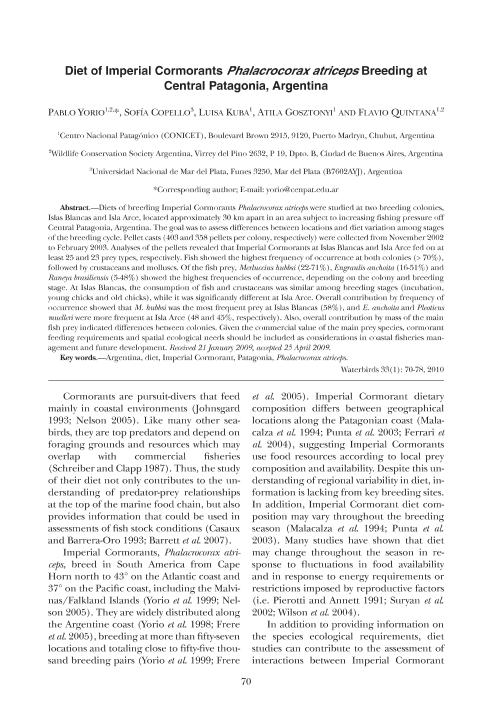Artículo
Diet of imperial Cormorants phalacrocorax atriceps breeding at Central Patagonia, Argentina
Yorio, Pablo Martin ; Copello, Sofía
; Copello, Sofía ; Kuba, Luisa
; Kuba, Luisa ; Gosztonyi, Atila Esteban
; Gosztonyi, Atila Esteban ; Quintana, Flavio Roberto
; Quintana, Flavio Roberto
 ; Copello, Sofía
; Copello, Sofía ; Kuba, Luisa
; Kuba, Luisa ; Gosztonyi, Atila Esteban
; Gosztonyi, Atila Esteban ; Quintana, Flavio Roberto
; Quintana, Flavio Roberto
Fecha de publicación:
03/2010
Editorial:
Waterbird Society
Revista:
Waterbirds
ISSN:
1524-4695
e-ISSN:
1938-5390
Idioma:
Inglés
Tipo de recurso:
Artículo publicado
Clasificación temática:
Resumen
Diets of breeding Imperial Cormorants Phalacrocorax atriceps were studied at two breeding colonies, Islas Blancas and Isla Arce, located approximately 30 km apart in an area subject to increasing fishing pressure off Central Patagonia, Argentina. The goal was to assess differences between locations and diet variation among stages of the breeding cycle. Pellet casts (403 and 358 pellets per colony, respectively) were collected from November 2002 to February 2003. Analyses of the pellets revealed that Imperial Cormorants at Islas Blancas and Isla Arce fed on at least 25 and 23 prey types, respectively. Fish showed the highest frequency of occurrence at both colonies (> 70%), followed by crustaceans and molluscs. Of the fish prey, Merluccius hubbsi (2271%), Engranlis anchoita (1651%) and Raneya brasiliensis (548%) showed the highest frequencies of occurrence, depending on the colony and breeding stage. At Islas Blancas, the consumption of fish and crustaceans was similar among breeding stages (incubation, young chicks and old chicks), while it was significantly different at Isla Arce. Overall contribution by frequency of occurrence showed that M. hubbsi was the most frequent prey at Islas Blancas (58%), and E. anchoita and Pleoticus muelleri were more frequent at Isla Arce (48 and 45%, respectively). Also, overall contribution by mass of the main fish prey indicated differences between colonies. Given the commercial value of the main prey species, cormorant feeding requirements and spatial ecological needs should be included as considerations in coastal fisheries management and future development.
Palabras clave:
Argentina
,
Diet
,
Imperial Cormorant
,
Patagonia
,
Phalacrocorax Atriceps
Archivos asociados
Licencia
Identificadores
Colecciones
Articulos(CCT - MAR DEL PLATA)
Articulos de CTRO.CIENTIFICO TECNOL.CONICET - MAR DEL PLATA
Articulos de CTRO.CIENTIFICO TECNOL.CONICET - MAR DEL PLATA
Articulos(CCT-CENPAT)
Articulos de CTRO.CIENTIFICO TECNOL.CONICET - CENPAT
Articulos de CTRO.CIENTIFICO TECNOL.CONICET - CENPAT
Citación
Yorio, Pablo Martin; Copello, Sofía; Kuba, Luisa; Gosztonyi, Atila Esteban; Quintana, Flavio Roberto; Diet of imperial Cormorants phalacrocorax atriceps breeding at Central Patagonia, Argentina; Waterbird Society; Waterbirds; 33; 1; 3-2010; 70-78
Compartir
Altmétricas



